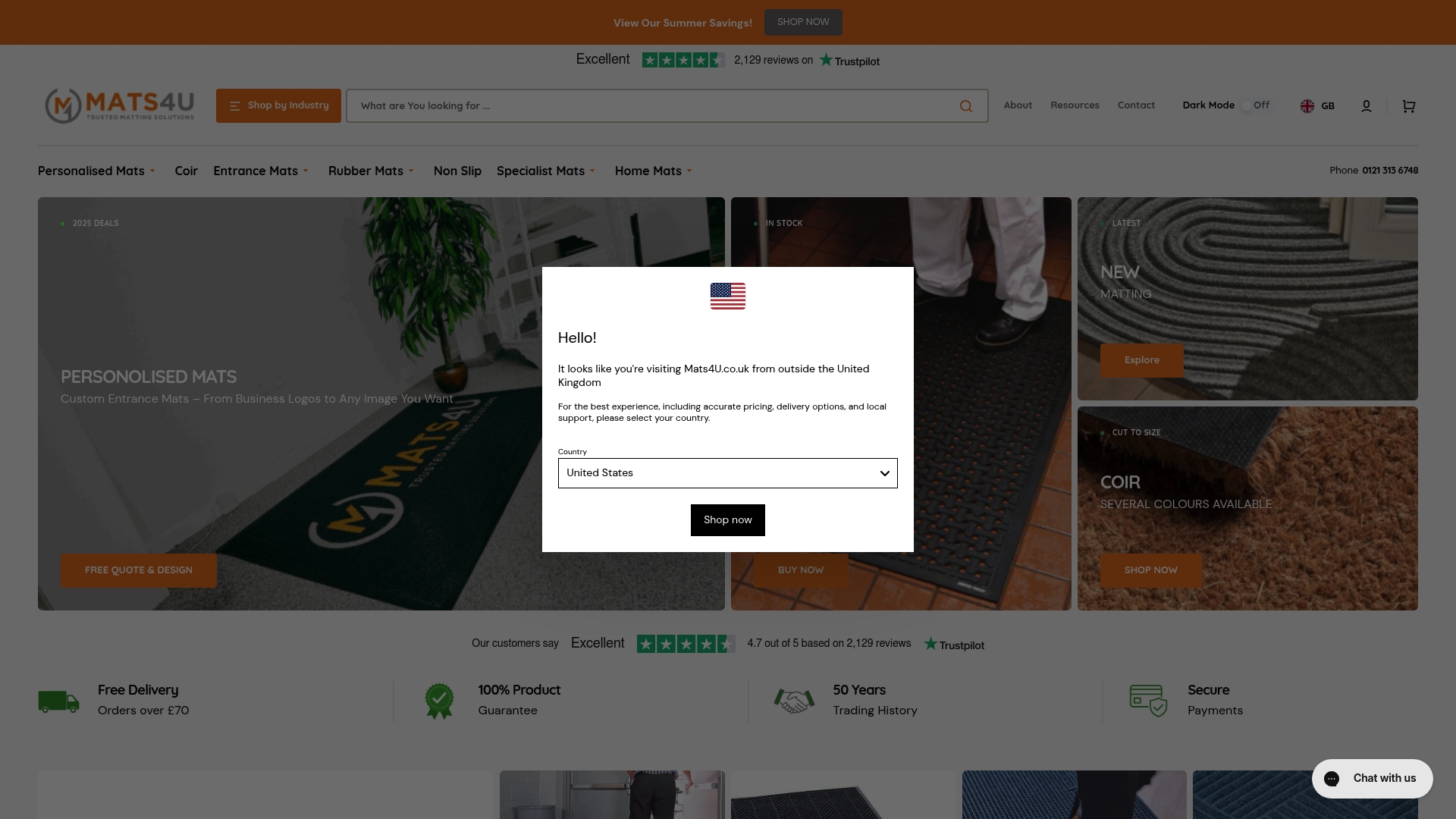Dust and debris can quietly threaten health and productivity across UK workplaces and yet over 80 percent of interior dirt is tracked in on shoes. Most businesses think a quick mop or regular hoovering does the job just fine. This belief ignores the power of dust control matting, which does more than stop dirt at the door and actually shapes a safer, cleaner, and far more professional working environment.
Table of Contents
- Understand The Importance Of Dust Control Matting
- Identify The Right Type Of Mat For Your Needs
- Choose The Best Location For Installation
- Maintain And Clean Your Dust Control Mats Regularly
- Train Staff On Proper Usage And Care
- Evaluate The Effectiveness Of Your Dust Control Solutions
- Upgrade Matting Solutions Based On Industry Trends
Quick Summary
| Takeaway | Explanation |
|---|---|
| Implement dust control matting to enhance cleanliness | Dust control mats prevent dirt and debris, crucial for maintaining a clean and safe environment in various industries. |
| Choose mats based on specific needs | Selecting the right mat involves considering traffic volume, material composition, and the unique contamination challenges of your workspace. |
| Strategically place mats at critical locations | Position mats at entry points and high-traffic areas to effectively trap contaminants before they enter clean workspaces. |
| Regular maintenance is essential for effectiveness | Daily cleaning and periodic deep cleaning ensure mats continue to perform at their best, maintaining hygiene and appearance. |
| Train staff on proper mat usage and care | Educating employees about the importance and maintenance of dust control mats fosters a collective responsibility for workplace cleanliness. |
1: Understand the Importance of Dust Control Matting
Dust control matting is a critical solution for maintaining clean, safe, and professional environments across various industries in the United Kingdom. These specialised floor coverings are far more than simple decorative elements they serve as strategic barriers that prevent dirt, dust, and debris from spreading throughout commercial and industrial spaces.
The significance of dust control matting cannot be overstated, particularly in sectors where cleanliness and hygiene are paramount. Understanding dust control solutions for various industries reveals how these mats play a crucial role in managing environmental contamination.
Key benefits of implementing effective dust control matting include:
-
Reducing workplace contamination by trapping particulate matter before it spreads
-
Minimising potential health risks associated with airborne dust particles
-
Protecting sensitive equipment from dust infiltration in industrial settings
In environments like manufacturing facilities, warehouses, construction sites, and healthcare institutions, dust control mats act as the first line of defence against particulate invasion. By strategically positioning these mats at entry points and high-traffic areas, businesses can significantly reduce the volume of dust and dirt tracked into critical work zones.
Moreover, dust control matting contributes to maintaining a professional appearance while simultaneously protecting flooring investments. The initial investment in quality matting solutions translates into long-term savings by reducing cleaning costs, minimising floor damage, and extending the lifespan of interior surfaces.
For UK businesses seeking comprehensive dust management, selecting the right matting solution requires careful consideration of specific environmental conditions, traffic patterns, and industry-specific requirements. Proper placement and regular maintenance are equally crucial in maximising the effectiveness of dust control strategies.
Understanding these fundamental principles ensures that organisations can create cleaner, safer, and more efficient working environments through strategic dust control matting implementations.
2: Identify the Right Type of Mat for Your Needs
Selecting the appropriate dust control mat is a nuanced process that demands careful consideration of your specific environmental requirements. Different industries and spaces necessitate unique matting solutions to effectively manage dust and debris while maintaining safety and cleanliness standards.
Maximise your brand visibility with branded mats demonstrates that mat selection goes beyond functional performance and can also serve strategic branding purposes.
When identifying the right dust control mat, consider these critical factors:
-
Material composition that matches your specific environmental conditions
-
Traffic volume and intensity in the designated area
-
Specific dust and contamination challenges unique to your workspace
For industrial environments like manufacturing facilities and construction sites, heavy-duty rubber or synthetic mats with robust dust trapping capabilities are recommended. These materials can withstand significant foot traffic and effectively capture particulate matter before it spreads.
In office and commercial settings, microfibre or carpet-style entrance mats provide excellent dust control while maintaining a professional aesthetic. These mats efficiently absorb moisture and trap fine particles, preventing them from spreading across clean interior spaces.
Healthcare and laboratory environments require specialised antimicrobial mats that not only control dust but also minimise potential contamination risks. Seamless design and easy-to-clean surfaces become paramount in these high-hygiene settings.
Consider additional factors such as:
-
Moisture resistance
-
Chemical compatibility
-
Temperature tolerance
-
Potential ergonomic benefits
Ultimately, successful dust control matting requires a strategic approach that balances functional performance, environmental specifics, and aesthetic considerations. By carefully evaluating your unique requirements, you can select mats that provide optimal protection and maintain a clean, professional environment.
3: Choose the Best Location for Installation
The strategic placement of dust control matting is crucial for maximising its effectiveness in preventing particulate contamination. Thoughtful installation goes far beyond simply laying down a mat it requires a comprehensive understanding of traffic patterns, entry points, and potential dust sources within your workspace.
Understanding outdoor mats for wet areas highlights the critical importance of location selection in mat performance and longevity.
Key strategic locations for dust control matting include:
-
Building entry points where external contaminants first enter
-
High traffic corridors connecting different workspace zones
-
Transition areas between clean and potentially dusty environments
Entrance zones represent the most critical installation area. These first few metres of flooring receive the highest concentration of dirt, dust, and moisture tracked in from external environments. By implementing a multi-zone matting strategy, businesses can create a progressive dust removal system.
The first external zone should feature robust scraper mats designed to remove larger debris and mud. Secondary interior zones can utilise moisture-absorbing and fine particle trapping mats that capture remaining contaminants before they spread deeper into the facility.
Industrial settings like manufacturing plants and warehouses require additional strategic considerations. Areas near machinery, production lines, and material processing zones demand specialised dust control solutions that can withstand heavy equipment movement and constant particulate generation.
Consider additional placement factors such as:
-
Proximity to ventilation systems
-
Natural walking pathways
-
Potential dust generation sources
Proper mat positioning is not a one-size-fits-all solution. Each workspace presents unique challenges that demand tailored approaches to dust control. Regular assessment and potential repositioning ensure ongoing effectiveness in maintaining clean, safe environments.
By carefully selecting and maintaining strategic mat locations, organisations can significantly reduce dust propagation, protect interior surfaces, and create healthier working environments.
4: Maintain and Clean Your Dust Control Mats Regularly
Regular maintenance of dust control mats is not merely a recommendation it is a critical practice for ensuring optimal performance and prolonging mat lifespan. Neglecting proper cleaning protocols can significantly reduce a mat’s effectiveness in trapping dust and potentially compromise workplace hygiene standards.
Master commercial mat cleaning for pristine results provides essential insights into developing a robust maintenance strategy for dust control matting.
Key maintenance practices include:
-
Daily surface debris removal using vacuum or sweeping techniques
-
Weekly deep cleaning to extract embedded particulate matter
-
Quarterly professional deep cleaning for comprehensive restoration
Frequency of cleaning depends on several critical factors such as traffic volume, environmental conditions, and specific industry requirements. High-traffic areas like manufacturing facilities and commercial entrances demand more frequent and intensive cleaning regimens compared to lower-use spaces.
For synthetic and rubber mats, recommended cleaning methods typically involve:
-
Regular vacuuming to remove loose particles
-
Periodic washing with appropriate cleaning solutions
-
Thorough drying to prevent moisture accumulation
Cotton and microfibre mats require gentler approaches, often involving specialised cleaning agents that maintain their dust-trapping microstructures without causing structural degradation.
Businesses should establish standardised cleaning protocols that account for:
-
Manufacturer recommendations
-
Specific mat material characteristics
-
Workplace contamination levels
Implementing a structured maintenance programme not only preserves mat performance but also contributes to overall workplace cleanliness, reduces long-term replacement costs, and supports healthier indoor environments.
Proper mat maintenance represents a small investment with significant returns in dust control efficiency, workplace appearance, and potential reduction in cleaning and replacement expenses.
5: Train Staff on Proper Usage and Care
Effective dust control matting goes beyond product selection and installation it requires comprehensive staff training to ensure optimal performance and longevity. Employees play a crucial role in maintaining the functionality of dust control systems through proper understanding and consistent application of best practices.
How to improve air quality for healthier workspaces underscores the importance of collaborative approaches in maintaining clean work environments.
Key training objectives should encompass:
-
Understanding the purpose of dust control matting
-
Recognising proper mat usage techniques
-
Implementing consistent maintenance protocols
Workplace induction programmes must include specific modules on dust control matting that educate staff about the critical role these floor coverings play in maintaining workplace hygiene. This training should address not just cleaning procedures, but also the potential consequences of improper mat usage.
Staff should be instructed on specific behavioural modifications, such as:
-
Ensuring footwear is thoroughly wiped on entry mats
-
Avoiding dragging equipment across dust control surfaces
-
Reporting any mat damage or reduced effectiveness immediately
For industrial and manufacturing environments, training becomes even more nuanced. Employees must understand how dust control mats interact with different types of workplace contaminants, from fine particulate matter in construction sites to chemical residues in laboratory settings.
Training programmes should incorporate practical demonstrations, including:
-
Correct cleaning techniques
-
Identification of mat wear and deterioration
-
Understanding cross-contamination risks
Management must emphasise that dust control matting is a collective responsibility. By creating a culture of awareness and proactive maintenance, organisations can significantly enhance the effectiveness of their dust control strategies.
Regular refresher training sessions help reinforce these principles, ensuring that dust control practices remain consistent and that staff understand the broader implications of their actions on workplace cleanliness and safety.
6: Evaluate the Effectiveness of Your Dust Control Solutions
Continuous evaluation of dust control matting performance is essential for maintaining optimal workplace cleanliness and protecting critical operational environments. A systematic approach to assessment ensures that your dust management strategies remain responsive to changing workplace conditions and evolving contamination challenges.
Understanding dust control mats for various industries provides valuable insights into developing comprehensive evaluation frameworks.
Key performance indicators for assessing dust control effectiveness include:
-
Quantifiable reduction in airborne particulate matter
-
Decreased cleaning frequency and intensity
-
Improved equipment and surface cleanliness
Objective measurement techniques are crucial for accurate performance assessment. This involves implementing both qualitative and quantitative evaluation methods that provide comprehensive insights into mat effectiveness.
Recommended evaluation strategies encompass:
-
Regular visual inspection of mat condition
-
Particulate capture rate measurements
-
Tracking workplace cleaning time and resource expenditure
Scientific measurement approaches can include using particle counters to determine the volume of dust trapped by mats before and after installation. These precise diagnostic tools provide empirical evidence of dust control performance, allowing businesses to make data-driven decisions about their matting solutions.
For industrial and commercial environments, additional assessment criteria might involve:
-
Impact on equipment maintenance cycles
-
Reduction in respiratory health risks
-
Cost savings from decreased cleaning requirements
Businesses should establish a quarterly review process that systematically examines dust control mat performance. This involves collecting data, analysing trends, and making informed adjustments to existing strategies.
Successful dust control is not a static solution but a dynamic process requiring continuous monitoring, adaptation, and refinement. By implementing rigorous evaluation protocols, organisations can ensure their dust management approaches remain effective, efficient, and responsive to evolving workplace challenges.
7: Upgrade Matting Solutions Based on Industry Trends
Staying ahead of emerging dust control matting technologies is crucial for organisations seeking to maintain optimal workplace cleanliness and operational efficiency. The landscape of dust management is continuously evolving, driven by advancements in materials science, sustainability practices, and innovative engineering solutions.
Understanding hotel sustainability practices highlights the growing importance of adaptive solutions in modern workplace environments.
Emerging trends in dust control matting demonstrate significant technological progression:
-
Nanotechnology-enhanced materials
-
Eco-friendly and recyclable mat compositions
-
Smart sensor-integrated dust tracking systems
Sustainable manufacturing has become a critical consideration for businesses selecting dust control solutions. Modern mats are increasingly designed with environmental impact in mind, utilising recycled materials and developing production processes that minimise carbon footprint.
Key innovations transforming dust control matting include:
-
Advanced microfibre technologies
-
Self-cleaning surface treatments
-
Antimicrobial embedded materials
Technological advancements are enabling multi-functional mat designs that go beyond traditional dust control. These innovative solutions now incorporate features such as:
-
Energy harvesting capabilities
-
Integrated air quality monitoring
-
Real-time contamination tracking
For UK businesses, staying informed about these technological developments means regularly reviewing and upgrading dust control strategies. The investment in cutting-edge matting solutions represents not just an operational improvement, but a commitment to workplace health, safety, and environmental responsibility.
Successful organisations will prioritise continuous learning, attending industry conferences, engaging with manufacturers, and maintaining a proactive approach to technological adaptation. By embracing these emerging trends, businesses can transform dust control from a simple maintenance task into a sophisticated, data-driven operational strategy.
The table below provides a comprehensive summary of the key steps, benefits, and considerations covered in the guide to effective dust control matting for UK workplaces.
| Step / Topic | Key Points and Actions | Benefits / Outcomes |
|---|---|---|
| Importance of Dust Control Matting | Acts as a barrier against dust, dirt, and debris; crucial in sectors prioritising cleanliness and hygiene | Reduces contamination, health risks, and cleaning costs; protects flooring |
| Identifying the Right Mat | Consider material (rubber, microfibre, antimicrobial), traffic volume, workplace-specific needs, and environmental factors | Optimal dust trapping, safety, and tailored effectiveness |
| Strategic Placement | Locate mats at entryways, high-traffic zones, and transition areas; use multi-zone strategies with scraper and absorbent mats | Maximises contaminant removal and floor protection |
| Regular Maintenance | Implement daily vacuuming, weekly deep cleaning, and quarterly professional care, following manufacturer guidance and adapting to traffic/environment | Maintains mat efficiency and hygiene; extends mat lifespan |
| Staff Training | Educate on purpose, correct usage, cleaning protocols, and reporting wear; foster a sense of collective responsibility | Consistent mat performance and cleaner environments |
| Performance Evaluation | Regularly inspect mats visually, measure particulate capture rates, and track cleaning/resource savings using both qualitative and quantitative assessments | Data-driven improvement, adaptive strategies, cost savings |
| Upgrading with Industry Trends | Adopt eco-friendly, nanotechnology, self-cleaning, and sensor-integrated mats; monitor innovations and review strategy regularly | Enhanced efficiency, sustainability, and alignment with best practices |
Upgrade Your Workplace with Professional Dust Control Matting
Struggling to keep dust and debris at bay in your business? If you’ve read through our ‘7 Essential Tips for Effective Dust Control Matting,’ you know that dirt, dust and moisture not only impact hygiene but also threaten the professional image and safety of your environment. From choosing the best materials and placement to regular maintenance and advanced training, every step counts for maximum dust control and efficiency.

It is time to move from theory to action. Explore the tailored solutions at Mats4U, where businesses across the UK find industry-specific mats supporting cleaner, safer and more professional spaces. Discover our extensive selection, from made-to-measure entrance mats to branded logo matting for any commercial or industrial setting. Take control of dust problems now by browsing our full range of custom matting options, or contact our team for expert advice. Protect your floors, boost your brand and create healthier workplaces with Mats4U. Your cleaner, safer environment starts today.
Frequently Asked Questions
How do I select the right type of dust control matting for my environment?
Choosing the right dust control matting involves assessing the material composition, traffic volume, and specific contamination challenges in your space. Evaluate your unique needs and opt for heavy-duty mats for industrial settings or microfibre mats for office environments.
What are the best locations for installing dust control mats?
Strategically place dust control mats at building entry points, high-traffic corridors, and transition zones to effectively capture dust and debris. Prioritise entrance areas to reduce dirt tracked into the facility, ensuring the first few metres of flooring are well-equipped to handle contaminants.
How often should I clean my dust control mats?
Regular cleaning should be performed daily to remove surface debris, with deeper cleanings carried out weekly and quarterly for comprehensive maintenance. Develop a cleaning schedule that suits your traffic and environmental conditions, ensuring mats remain effective and hygienic.
What training should I provide to staff regarding dust control mats?
Train staff on the purpose of dust control mats, proper usage techniques, and maintenance protocols to ensure optimal mat performance. Focus on demonstrating effective cleaning methods and the significance of avoiding behaviours that may damage the mats, like dragging equipment.
How can I evaluate the effectiveness of my dust control solutions?
Evaluate your dust control mats by conducting regular visual inspections and measuring particulate capture rates. Implement a quarterly review process to track improvements in workplace cleanliness and adjust your strategies as needed for continued effectiveness.
What recent trends should I be aware of when upgrading dust control matting?
Stay informed about emerging trends like eco-friendly materials and smart technologies that enhance dust control capabilities. Regularly review advancements in matting solutions to ensure your strategies remain effective and environmentally responsible.
Recommended
- Master Commercial Mat Cleaning for Pristine Results – Mats4U
- Understanding Outdoor Mats for Wet Areas – Mats4U
- Understanding Dust Control Mats for Various Industries – Mats4U
- How to Improve Air Quality for Healthier Workspaces – Mats4U
- Common Mistakes in PPF Installation and How to Avoid Them – AEONCUT PPF Pre-cut Cutting software









